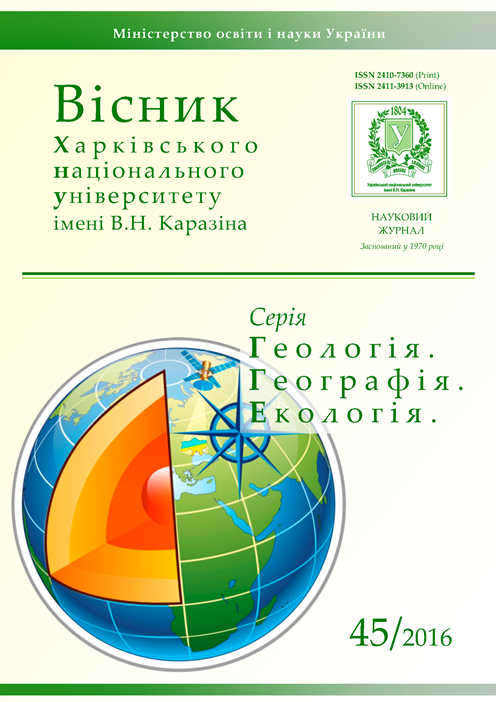Development of waste disposal effective technologies by power generating and chemical industries
Abstract
The article describes the conditions and characteristics of accumulation of large-capacity waste from fuel and energy complex and chemical industry in the Ukraine. Technological preconditions of large amount of large-capacity waste accumulation in the industrialized regions of Ukraine are described and a consistent trend of growth is revealed. It is indicated that industrial wastes often contain heavy, rare and rare earth metals in amounts that give the opportunity to appreciate them as technological fields. The experience of using large-capacity waste from fuel and energy complex and chemical industry in the EU and the USA is analysed.The trends to accumulate toxic industrial wastes at enterprises of Ukraine for the past 15 years have been considered. It has been established that the utilization of ash and slag valuable components requires knowledge of chemical and phase-mineralogical composition of the waste, which is determined by the composition of the mineral part of the initial fuel and way of burning. The waste is in ash and slag producing enterprises of the fuel and energy complex which are kind of the hub of the items contained in the fuel. The composition of the ash waste was studied taking into account characteristics of the coals in Donbass. It is established that the use of the Ukrainian coal leads to additional environmental problems related to high content of sulfur and ash in coal. One of the solutions to the problems is the technology of extracting vanadium from ash waste. EU countries have experience of using phosphogypsum. The use of phosphogypsum as an additive in mortar has proved efficient, especially in the manufacture of decorative plates and large size sheet materials for decoration. Investigations of the waste composition have been carried out on the territory of the plant "Crimean Titan". It is revealed that the production of gypsum binders and phosphogypsum products on their basis is economically feasible, which in this case is not treated as waste but rather as secondary raw materials. Standard characteristics of phosphogypsum used as raw material have been identified. The flowcharts of phosphogypsum use with economically viable payback period 2-2.5 have been built.
Downloads
References
2. Kapinus, E. I., Shpil'nyj, S. A., Shchegolev, A. K. (2000). Izvlechenie cvetnyh metallov iz zoly i shlaka kamennogo uglya Donbassa s pomoshch'yu solyanoj kisloty [Extraction of non-ferrous metals from the ash and slag of coal in Donbass with hydrochloric acid]. Ecological Technologies and Resource Saving, 6, 21–26.
3. Kasimov, A. M., Dzhafarov, Y. U. (2004). Vozdejstvie nakopitelej promyshlennyh othodov na okruzhayushchuyu sredu [The impact storage industrial waste on the environment]. Man and the environment. Problems of Neo-ecology, 5, 64–67.
4. Kasimov, A. M., Semenov, V. T., Shcherban', N. G., Myasoedov, V. V. (2008). Sovremennye problemy i resheniya v sisteme upravleniya opasnymi othodami [Modern problems and solutions in the management system of the haz-ardous waste]. Kh., KhNUUE, 511.
5. Kasimov, A. M., Tovazhnyanskij, L. L., Toshinskij, V. I., Stalinskij, D. V. (2009). Sovremennye problemy i resheniya v sisteme upravleniya opasnymi othodami: monografiya [Modern problems and solutions in the management system of the hazardous waste: monograph]. Kh., Publishing house NTU «KhPI», 512.
6. Kasimov, A. M., Udalov, I. V. (2014). Ekologo-ehkonomicheskie metody sokrashcheniya ushcherba okruzhayushchej srede, nanosimogo nakopitelyami othodov [Ecological and economic methods of reducing environmental damage are caused by waste storage]. Visnyk of V. N. Karazin Kharkiv National University, series "Geology. Geography. Ecology", 41, 133–139.
7. Kovalenko, G. D., Rudja, K. G. (2001). Radiojekologija Ukrainy: monografiya [Radioecology of Ukraine: monograph]. K., CPI, Kiev University, 154.
8. Kovalyov, A. A., Kohanenko, V. B. (2010). Ehkologicheskaya opasnost' zoloshlakovyh othodov predpriyatij promyshlennoj ehnergetiki [Environmental risk of ash wastes of industrial enterprises of power]. Kharkiv,
KhNAHU, 88–90.
9. Mіnka, S. V., Ershova, N. M. (2009). Ekologіchnij zahist teritorіj shlyahom vikoristannya zoloshlakіv TES u tekhnologіi virobnictva zalіzobetonu [Environmental protection areas by the use of ash and slag from power station in technology production of reinforced concrete]. Systems of processing information, 3 (77), 146–149.
10. Nikitin, A. N., Ermakova, E. V. (2006). Shlamovye othody teplovyh ehlektrostancij – istochniki zagryazneniya at-mosfernogo vozduha i potencial'nye resursy mineral'nogo syr'ya [Sludge waste of the thermal power plants - sou-rces of air pollution and the potential resources of mineral raw materials]. News TSU, Series Physics, 6, 96–111.
11. Panov, B. S. (1993). Nekotorye voprosy ehkologicheskoj mineralogii Doneckogo bassejna [Some issues of ecological mineralogy in Donets Basin]. Mineralogical Magazine, 15 (6), 43–50.
12. Rekomendacii po primeneniyu v betonah zoly, shlaka i zoloshlakovoj smesi teplovyh ehlektrostancij (1986).[Recommendations for use in concrete ash, slag and ash-slag mixture of thermal power plants]. M., Stroiiz-dat, 80.
13. Seminozhenko, V. P., Stalinskij, D. V., Kasimov, A. M. (2011). Promyshlennye othody: problemy i resheniya [Indus-trial waste: problems and solutions] Monograph. Kh., «Industry», 544.
14. Sergeev, A. M. (1984). Ispol'zovanie v stroitel'stve othodov ehnergeticheskoj promyshlennosti [Use in the construc-tion the waste of energy industry]. K., Builder, 120.
15. Solovej, V.V., Vorob'yova, I.A., Volovina, T.V. (2006). Tekhnologiya utilizacii zoloshlakovyh othodov tvyordotoplivnyh ehlektrostancij [Technology disposal of ash and slag waste in solid-fuel power stations]. Kharkiv, 142.
16. Chelyadin, L. І., Chelyadin, V. L., Timoshenko, V. Ya. (2006). Tekhnogennі materіali ta ih utilіzacіya і vpliv na ekologіyu regіonu [Technogenic materials and their recycling and impact on ecology region]. Ecology of Environmental and Safety life, 1, 80–86.
17. Shutenko L. M. (2002). Mіs'kij zhitlovij fond: zhittvij cikl і radіacіjna bezpeka [Municipal housing, life cycle and radiation safety]. K., Technіka, 251.
18. Elinzon M. P., Vasil'kov S. G. (1980). Toplivosoderzhashchie othody promyshlennosti v proizvodstve stroitel'nyh materialov [Of fuel-industrial waste in the production of building materials]. M., Stroiizdat, 223.
19. Yanov, N. K. (1981). Ispolzovanie promyishlennyih othodov v stroitelstve [Use of industrial wastes in the construc-tion]. K., Builder, 60.





